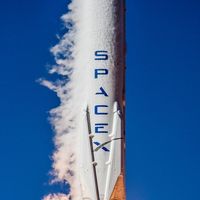NASA's Budget Cuts: A Leap Towards Mars or a Step Back?
May 3, 2025, 10:57 pm

Location: United States, District of Columbia, Washington
Employees: 5001-10000
Founded date: 2002
Total raised: $7.53B

Location: United States, Maryland, Greenbelt
Employees: 10001+
Founded date: 1958
Total raised: $25.7B
The cosmos is vast, but the budget is tight. The Trump administration's latest proposal to slash NASA's budget by $6 billion raises eyebrows and questions. The plan reallocates $1 billion towards Mars missions, echoing the ambitions of private space ventures like SpaceX. But is this a bold leap into the future or a reckless gamble?
NASA, the crown jewel of American space exploration, faces a storm. The proposed budget cuts threaten to reshape its very foundation. With a 25% reduction in funding, the agency must make tough choices. The focus shifts to Mars, a red dot on the horizon, while other missions fade into the background.
The proposed budget prioritizes human exploration. More than $7 billion is earmarked for moon exploration and Mars initiatives. This aligns with the administration's vision of beating China back to the Moon and landing humans on Mars. But at what cost? The budget cuts hit space science and Earth science hard, with reductions exceeding $2.2 billion and $1.1 billion, respectively. The casualties of this budget war include the Mars Sample Return mission, a project once seen as a cornerstone of Martian exploration.
NASA's acting administrator, Janet Petro, calls for resilience. She urges employees to adapt to a new reality. The message is clear: tough times require tough choices. The agency must streamline operations, cut workforce numbers, and terminate “unaffordable” missions. The dream of exploring the cosmos is now tethered to fiscal responsibility.
The budget's focus on Mars aligns with the ambitions of private players like SpaceX. Elon Musk's vision of colonizing Mars has captivated the public's imagination. SpaceX aims to launch a manned mission to Mars, a goal that has been both ambitious and controversial. Musk's aggressive timelines often raise skepticism, but his influence on the administration is undeniable. The proposed budget seems to cater to this vision, potentially sidelining other scientific endeavors.
The Space Launch System (SLS) and Orion spacecraft, once hailed as the future of NASA's deep space exploration, face retirement under the new budget. This decision raises questions about the agency's long-term strategy. The SLS has been plagued by delays and cost overruns, with estimates ballooning to $93 billion by the time Artemis III launches. Critics argue that alternatives, such as SpaceX's Starship or Blue Origin's New Glenn, could provide more efficient and cost-effective solutions.
NASA's Office of the Inspector General has previously warned about the rising costs of the SLS and Orion. The audit suggested exploring commercial alternatives that could meet mission needs more effectively. The proposed budget seems to heed this advice, but at a steep price. The focus on Mars may come at the expense of other vital scientific research. The cuts to space science and Earth science threaten to stifle innovation and exploration in these critical areas.
The budget proposal also reflects a broader trend in government spending. The Trump administration's push for efficiency and reduced federal spending has led to a reevaluation of priorities. While the desire to return to the Moon and send humans to Mars is commendable, the cuts to scientific research could have long-term consequences. The exploration of our planet and the universe should not be sacrificed on the altar of budgetary constraints.
As the Senate considers the nomination of Jared Isaacman to lead NASA, the agency stands at a crossroads. Isaacman, a tech entrepreneur, embodies the shift towards commercial space ventures. His leadership could usher in a new era for NASA, one that embraces partnerships with private companies. However, this shift must not come at the expense of NASA's core mission: scientific discovery and exploration.
The proposed budget cuts may be a calculated risk, but they also represent a departure from NASA's legacy. The agency has always been a beacon of innovation and exploration. It has inspired generations to look to the stars. The focus on Mars is exciting, but it should not eclipse the importance of understanding our own planet and the universe around us.
In conclusion, NASA's budget cuts present a complex dilemma. The ambition to explore Mars is commendable, but the sacrifices made in other areas raise concerns. The future of space exploration should not be a zero-sum game. As we reach for the stars, we must also keep our feet firmly planted on the ground. The cosmos is calling, but we must ensure that our journey is balanced, inclusive, and sustainable. The stars await, but so do the challenges of our own planet. The path forward must embrace both.
NASA, the crown jewel of American space exploration, faces a storm. The proposed budget cuts threaten to reshape its very foundation. With a 25% reduction in funding, the agency must make tough choices. The focus shifts to Mars, a red dot on the horizon, while other missions fade into the background.
The proposed budget prioritizes human exploration. More than $7 billion is earmarked for moon exploration and Mars initiatives. This aligns with the administration's vision of beating China back to the Moon and landing humans on Mars. But at what cost? The budget cuts hit space science and Earth science hard, with reductions exceeding $2.2 billion and $1.1 billion, respectively. The casualties of this budget war include the Mars Sample Return mission, a project once seen as a cornerstone of Martian exploration.
NASA's acting administrator, Janet Petro, calls for resilience. She urges employees to adapt to a new reality. The message is clear: tough times require tough choices. The agency must streamline operations, cut workforce numbers, and terminate “unaffordable” missions. The dream of exploring the cosmos is now tethered to fiscal responsibility.
The budget's focus on Mars aligns with the ambitions of private players like SpaceX. Elon Musk's vision of colonizing Mars has captivated the public's imagination. SpaceX aims to launch a manned mission to Mars, a goal that has been both ambitious and controversial. Musk's aggressive timelines often raise skepticism, but his influence on the administration is undeniable. The proposed budget seems to cater to this vision, potentially sidelining other scientific endeavors.
The Space Launch System (SLS) and Orion spacecraft, once hailed as the future of NASA's deep space exploration, face retirement under the new budget. This decision raises questions about the agency's long-term strategy. The SLS has been plagued by delays and cost overruns, with estimates ballooning to $93 billion by the time Artemis III launches. Critics argue that alternatives, such as SpaceX's Starship or Blue Origin's New Glenn, could provide more efficient and cost-effective solutions.
NASA's Office of the Inspector General has previously warned about the rising costs of the SLS and Orion. The audit suggested exploring commercial alternatives that could meet mission needs more effectively. The proposed budget seems to heed this advice, but at a steep price. The focus on Mars may come at the expense of other vital scientific research. The cuts to space science and Earth science threaten to stifle innovation and exploration in these critical areas.
The budget proposal also reflects a broader trend in government spending. The Trump administration's push for efficiency and reduced federal spending has led to a reevaluation of priorities. While the desire to return to the Moon and send humans to Mars is commendable, the cuts to scientific research could have long-term consequences. The exploration of our planet and the universe should not be sacrificed on the altar of budgetary constraints.
As the Senate considers the nomination of Jared Isaacman to lead NASA, the agency stands at a crossroads. Isaacman, a tech entrepreneur, embodies the shift towards commercial space ventures. His leadership could usher in a new era for NASA, one that embraces partnerships with private companies. However, this shift must not come at the expense of NASA's core mission: scientific discovery and exploration.
The proposed budget cuts may be a calculated risk, but they also represent a departure from NASA's legacy. The agency has always been a beacon of innovation and exploration. It has inspired generations to look to the stars. The focus on Mars is exciting, but it should not eclipse the importance of understanding our own planet and the universe around us.
In conclusion, NASA's budget cuts present a complex dilemma. The ambition to explore Mars is commendable, but the sacrifices made in other areas raise concerns. The future of space exploration should not be a zero-sum game. As we reach for the stars, we must also keep our feet firmly planted on the ground. The cosmos is calling, but we must ensure that our journey is balanced, inclusive, and sustainable. The stars await, but so do the challenges of our own planet. The path forward must embrace both.
